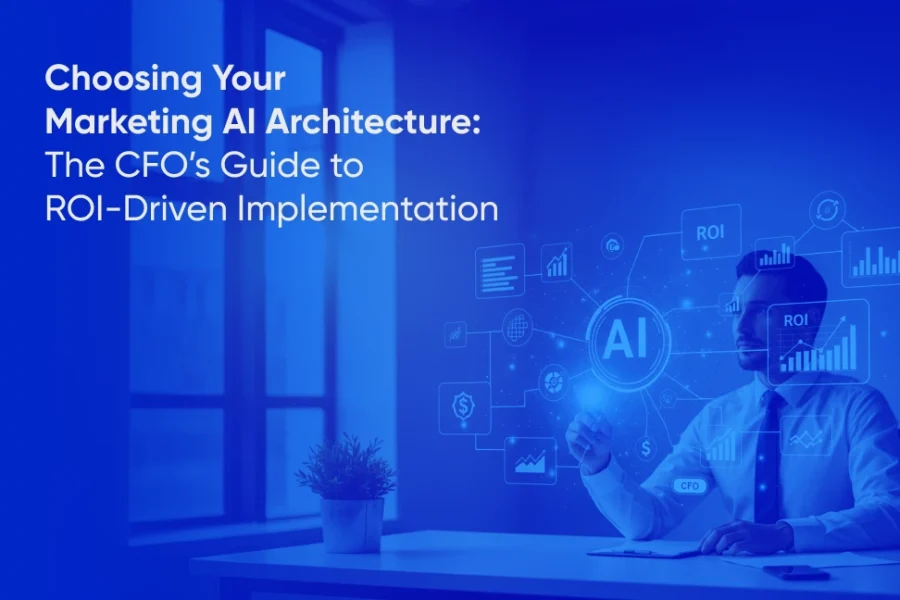When marketing leaders propose implementing AI, CFOs don’t ask “How cool is it?”
They ask, “What’s the ROI?”
And rightly so.
According to a 2024 Deloitte Insights study, only 27% of companies report significant financial benefits from their AI investments.
The rest?
They either chose the wrong architecture, underestimated data readiness, or fell into the trap of over-promising AI without a realistic execution plan.
This guide is built for decision-makers who want results, not just buzzwords.
It’s for CFOs, CMOs and digital transformation leads who need a clear, financially sound framework to select the right AI architecture based on:
1. Business Objectives
“What core outcomes are we trying to drive, and how measurable are they?”
Definition:
The strategic goals your organization aims to achieve through AI adoption in marketing — typically tied to growth, efficiency, or customer experience. These define the role AI will play: revenue acceleration, cost reduction, retention uplift, lead generation, or brand lift.
Examples:
- Drive 20% uplift in ROAS in paid media
- Reduce customer churn by 15%
- Shorten sales cycle by 30%
- Increase marketing productivity per dollar spent
Why It Matters:
Your AI architecture must align with the type and complexity of desired outcomes. Autonomous architectures are best for real-time optimization, while orchestrator models serve longer-cycle brand or B2B goals.
2. Team Structure
“Do we have the right roles, capacity, and collaboration model to support AI deployment?”
Definition:
The size, skill composition, and operational maturity of your internal marketing, data, and technology teams. Includes how well your teams collaborate cross-functionally (marketing + data science + engineering).
Examples:
- Presence of marketing operations or growth teams
- In-house data engineers or reliance on agency partners
- Org readiness for AI ownership vs. outsourcing
Why It Matters:
Agentic architectures require high autonomy and continuous support. If your team lacks embedded data capabilities, a more guided or orchestrated system is safer.
3. Data Maturity
“Do we have the quality, granularity, and integration of data needed to fuel AI?”
Definition:
How advanced your organization is in collecting, unifying, and using data. Includes data cleanliness, real-time availability, attribution setup, and use of cloud infrastructure or CDPs.
Maturity Stages:
- Basic: Disconnected tools, manual reports, no clear tracking
- Intermediate: Tag management, some CRM integration, lagging dashboards
- Advanced: Unified IDs, event-based tracking, real-time data warehouse
Why It Matters:
IBM research shows 89% of AI failures stem from data issues. Agentic and autonomous systems demand rich, structured, real-time data to learn and act effectively.
4. Execution Complexity
“What’s the scale and variability of the marketing operations we’re automating?”
Definition:
The volume, diversity, and dynamic nature of your marketing programs. This includes the number of campaigns, channels, markets, buyer journeys, personalization layers, and how frequently these shift.
Indicators of High Complexity:
- 10+ audience segments
- Cross-border localization
- High-frequency testing and variant production
- Multiple KPIs across funnel stages
Why It Matters:
Autonomous or hybrid orchestrator-worker architectures thrive in complex environments. Simpler or lower-variation businesses can do more with rule-based or prompt-chaining systems.
5. Time-to-Value
“How soon do we need results, and how much experimentation can we tolerate?”
Definition:
The acceptable timeline between AI implementation and measurable performance improvement. Also includes the organization’s risk appetite and willingness to invest in longer-term capability building.
Time Horizon Types:
- Short-term (< 3 months): Fast pilot, tangible impact needed
- Mid-term (3–6 months): Willing to experiment and course-correct
- Long-term (> 6 months): Strategic shift, cultural and technical overhaul
Why It Matters:
According to Deloitte’s 2024 AI in Marketing Report, 63% of failed AI deployments underestimated change timelines. If you need quick wins, a modular or orchestrator-led setup works better than building full autonomy from scratch.
Why Choosing the Right AI Architecture Matters
AI isn’t a tool. It’s a system of systems.
Choose wrong, and you risk:
- High upfront costs with minimal return
- Siloed execution with no compounding advantage
- Burned-out teams chasing overengineered solutions
- Missed windows of opportunity due to slow optimization cycles
According to IBM’s Global AI Adoption Index (2023):
“One in four AI projects fails because the architecture is misaligned with organizational goals and deployment capacity.”
In simple terms: AI fails when strategy and structure don’t align.
“A successful AI initiative isn’t just about intelligence. It’s about architecture aligned to ROI.”
– Tatvic Agentic AI Team, 2025
The 4 Pillars of ROI-Driven Architecture Selection
1. Business Objective Fit
Your AI system must align to what drives your business’s P&L:
Business Goal |
Best-fit Architecture |
Why It Works |
| Lead Gen at Scale | Orchestrator-Worker Model | Automates 1:many personalization fast |
| Retention + LTV Growth | Autonomous Agents | Predictive behavior + continuous action |
| Operational Efficiency | Prompt Chaining or Hybrid | Streamlines repetitive decisions |
| Real-Time Media Optimization | Parallel Agent Systems | Executes decisions at speed + scale |
Capgemini Research Institute finds:
“Companies aligning AI with clear business goals see 39% higher ROI in the first year.”
2. Data Maturity + Infrastructure
Not all architectures are data-agnostic. Some require rich data histories, while others can start small and learn over time.
Your Data Reality |
Suitable AI Model |
| Large, clean, structured datasets | Autonomous Agents |
| Some customer + campaign data | Orchestrator-Worker |
| Fragmented or limited data | Prompt Chaining or Rule-Based AI |
According to Deloitte:
“68% of failed AI initiatives cite poor data quality as a top challenge.”
– Deloitte State of AI in the Enterprise, 5th Edition
3. Team + Execution Capability
AI is not plug-and-play.
You must assess operational bandwidth to maintain and evolve the system:
Team Capability |
Architecture Fit |
| Strong ML/DevOps + Engineering Team | Autonomous/Parallel Systems |
| Mid-sized team with ops bandwidth | Orchestrator-Worker or Hybrid |
| Lean marketing-only team | Prompt Chaining or Co-Pilot AI |
IBM Research (2023) shows:
“Organizations with centralized AI Centers of Excellence outperform peers in scaling ROI by 43%.”
4. Time-to-Value
The architecture must align with how fast you need to see results:
Timeframe |
Architecture |
Remarks |
| Immediate (30–60 days) | Prompt Chaining or Co-Pilot | Low dev lift, fast to deploy |
| Medium (2–4 months) | Orchestrator-Worker | Requires setup, shows ROI soon |
| Long (6+ months) | Autonomous/Parallel Agents | Needs training + data; high payoff later |
Real-World Implementation Examples
1. B2B SaaS Brand (Mid-size, $20M ARR)
- Need: Reduce CAC by 20% through paid ad optimization
- Architecture Chosen: Orchestrator + Ad Channel Agents
- Results:
- CAC reduced by 23%
- 4x faster creative testing cycles
- ROAS uplift by 36% in 90 days
- CAC reduced by 23%
2. Retail Enterprise (Global, $800M Revenue)
- Need: Predict churn + trigger retention journeys
- Architecture Chosen: Autonomous Agent System
- Results:
- Churn reduced by 18%
- Retention emails personalized at 1:1 scale
- $11M LTV growth in Year 1
- Churn reduced by 18%
Decision Matrix: Which Architecture Is Right for You?
Factor |
Prompt Chaining |
Orchestrator-Worker |
Autonomous Agents |
Parallel Agent Systems |
| Time-to-Market | ✅✅✅ | ✅✅ | ❌ | ❌ |
| Engineering Requirement | Low | Medium | High | Very High |
| Data Maturity Needed | Low | Medium | High | Very High |
| Use Case Complexity | Simple | Moderate | Advanced | Complex |
| Long-term ROI Potential | Medium | High | ✅✅✅ | ✅✅✅✅ |
Final Thoughts: A CFO’s Checklist Before Investing in AI Architecture
- Do we have a clear business KPI tied to this AI initiative?
- Is our data mature enough for the architecture being proposed?
- Do we have the engineering + ops muscle to maintain this?
- What is our expected time-to-value and how will we measure it?
- Is this scalable or will we need to rebuild in 12 months?
Ready to implement the perfect architecture in your marketing operations?
Explore our Agentic AI services or calculate your potential continuous optimization gains with our ROI calculator


